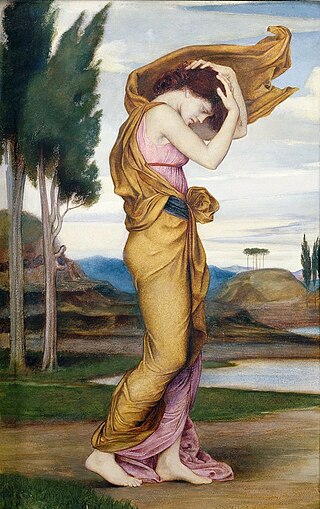Top Qs
Timeline
Chat
Perspective
Deianira
Ancient Greek mythical character From Wikipedia, the free encyclopedia
Remove ads
Deianira, Deïanira, or Deianeira[1] (/ˌdiːəˈnaɪrə/ DEE-ə-NY-rə;[2] Ancient Greek: Δηϊάνειρα, romanized: Dēiáneira, or Δῃάνειρα, Dēáneira, IPA: [dɛːiáneːra]), also known as Dejanira,[3] is a Calydonian princess in Greek mythology whose name translates as "man-destroyer"[4] or "destroyer of her husband".[5][6] She was the wife of Heracles and, in late Classical accounts, his unwitting murderer, killing him with the poisoned Shirt of Nessus. She is the main character in Sophocles' play Women of Trachis.
Remove ads
Family
Deianira was the daughter of Althaea and her husband Oeneus[7] (whose name means "wine-man"), the king of Calydon (after the wine-god gave the king the vine to cultivate), and the sister of Meleager. Her other siblings were Toxeus, Clymenus, Periphas, Agelaus (or Ageleus), Thyreus (or Phereus or Pheres), Gorge, Eurymede and Melanippe.[8][9]
In some accounts, Deianira was the daughter of King Dexamenus of Olenus[10] and thus, sister to Eurypylus,[11] Theronice and Theraephone.[12] Others called this daughter of Dexamenus as Mnesimache[13] or Hippolyte.[14]
Deianira was the mother of Onites,[15] Hyllus, Glenus, Onites, Ctesippus, and Macaria, who saved the Athenians from defeat by Eurystheus.
Remove ads
Mythology and literature
Summarize
Perspective



Marriage
In Sophocles' account of Deianira's marriage, she was courted by the river god Achelous, but was saved from having to marry him by Heracles, who defeated Achelous in a wrestling contest for her hand in marriage.[16]
In another version of the tale, where she was described as the daughter of Dexamenus, Heracles raped her and promised to come back and marry her. While he was away, the centaur Eurytion appeared and demanded her as his wife. Her father, being afraid, agreed, but Heracles returned before the marriage and slew the centaur and claimed his bride.[17]

Deianira was associated with combat, and was described as someone who "drove a chariot and practiced the art of war."[18]
Death of Heracles
The most famous story containing Deianira concerns the Shirt of Nessus. A wild centaur named Nessus attempted to kidnap or rape Deianira as he was ferrying her across the river Euenos, but she was rescued by Heracles, who shot the centaur with an arrow laced with the venom of the Hydra. As he lay dying, Nessus persuaded Deianira to take a sample of his blood, claiming that, when mixed with his semen, it would create a love potion that would ensure Heracles would never again be unfaithful.[19]
When Heracles fell in love with the younger and more beautiful Iole, Deianira, fearing that she would lose her husband, decided to use the potion. She soaked a tunic or shirt (perhaps Heracles' famous lionskin shirt) in the potion. When Heracles put on the shirt, the venom from the very arrow he had used to kill Nessus began to burn and eat away at his skin. When he tried to remove the shirt, he tore off chunks of his own flesh. Eventually, unable to bear the pain any longer, Heracles built a funeral pyre and immolated himself. When Deianira realized what she had done, she committed suicide, either by hanging or by a sword.[20]
| Preceded by Omphale |
Wives of Heracles | Succeeded by Hebe |
Middle Age tradition
She is remembered in De Mulieribus Claris, a collection of biographies of historical and mythological women by the Florentine author Giovanni Boccaccio, composed in 1361–62. It is notable as the first collection devoted exclusively to biographies of women in Western literature.[21]
Remove ads
Calydonian family tree
Notes
References
External links
Wikiwand - on
Seamless Wikipedia browsing. On steroids.
Remove ads

